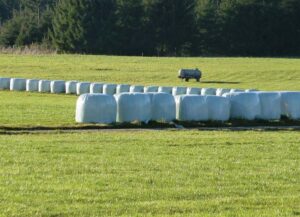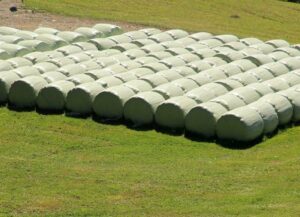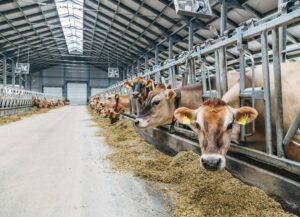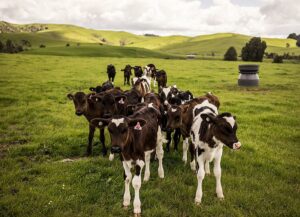Maria Villagrasa
In Brazil, sugar cane is generally used as silage to feed livestock. However, when silage shows a fermentative pattern characterized by high ethanol production and sugar losses due to the action of yeasts, it results in a reduction of its nutritional value as a result of dry matter (DM) losses.
Urea is often used as an additive in silage as it transforms into ammonia and reacts with water to form ammonium hydroxide. A product has been developed called “protected urea” that has a controlled release of ammonia and reduces the buffering effect caused by conventional urea; it also allows for a greater concentration to be used at ensiling.
A work (Wagner Sousa-Alves et al., 2020) was carried out to compare the fermentative characteristics of the addition of protected or conventional urea to sugarcane silage and evaluate its nutritional value.
The design compared sugarcane silage without additives as control with two other silages containing two types of urea (conventional and protected) added at two concentrations (0.5 and 1.0% forage dry matter; DM).
The sugar cane was cut with a harvester to obtain a particle size of 1 to 2 cm. Four piles of 20 kg fresh sugar cane were collected, and conventional or protected urea were added to them in the desired proportions, and then homogenized. Silages were prepared in PVC silos of 50 cm height and 10 cm diameter. The silos were sealed, stored at room temperature (25°C) and opened after 60 days.
Dry matter content and effluent losses between silages showed no differences with the addition of urea. With respect to pH, significant differences were observed between silage with conventional urea at 1.0% compared to the control (3.50 vs. 3.37). The fraction of ammonia nitrogen (N-NH3/% total N) of treatments with urea at 1.0% (18.6%) was greater than that of the treatment with 0.5% (15.3%) and the control (11.8%). In relation to the type of urea, the conventional treatment showed a fraction greater than the protected (19.3 vs. 14.5%). With regards to the gas losses, they were lower in all urea treatments compared to silage control.
Chemical composition of sugarcane silage
The chemical composition of sugarcane silage showed the following:
- Protein (%DM): the addition of urea significantly increased protein concentration with respect to the control (protected 0.5% = 8.83%; protected 1.0% = 14.6%; conventional 0.5% = 9.67%; conventional 1.0% = 15.4%; control = 3.88%).
- Acid and neutral detergent fibers and lignin (% DM): reductions in NDF, ADF and lignin were observed in the fibrous fraction compared to that of the control. All treatments differed from the control in NDF (protected 0.5% = 46.9%; protected 1.0% = 44.7%; conventional 0.5% = 44.6%; conventional 1.0% = 44.3%; control = 52.0%).
For ADF, only the silage with 1% conventional urea differed from the control (24.0 vs. 28.1% DM); for lignin, all treatments with urea at 1%, regardless of type, differed from the control (protected 1.0% = 16.0%; conventional 1.0% = 16.1%; control = 19.6%).
Ruminal degradation parameters of silage DM
Ruminal degradation parameters showed the following:
- Rapidly degradable fraction at 0 h incubation (fraction a; %): treating the silage with urea (conventional or protected) reduced the fraction in relation to the control. There was a significant interaction between dose and type of urea, so that the highest average was observed in the silage with conventional urea at 0% (protected 0.5% = 32.9%; protected 1.0% = 41.3%; conventional 0.5% = 39.0%; conventional 1.0% = 42.0%; control = 44.0%).
- Insoluble degradable fraction (fraction b; %): a significant interaction was found between both dose and type of urea, with a higher average for the dose of 0.5% than 0%. (22.3 vs. 20.1%) and for protected than conventional urea (22.0 vs 19.8%). There was also a difference between protected urea treatment at 0.5% and control (24.0 vs 19.1%).
- Degradation rate of fraction b (fraction c; % per hour): no differences were observed between treatments, with averages of 2.2% per hour.
- Potential and effective degradability(%): the inclusion of urea reduced both the potential and effective degradability of DM compared to that of the control regardless of the type and dose of urea; the highest average was for 1% protected urea in both cases.
- Non-degradable fraction (%): the inclusion of urea in silage increased the non-degradable fraction of DM relative to the control. There was a significant interaction between dose and type of urea, so that protected urea at 0.5% had the highest average (protected 0.5% = 43.0%; protected 1% = 37.2%; conventional 0.5% = 40.3%; conventional 1% = 38.0%; control = 36.7%).
These results indicate that the inclusion of protected or conventional urea at 1% of forage dry matter in sugarcane silage reduces gas losses and improves nutritional composition, as well as increases the raw protein and reduces the fiber fraction.
Reference
Sousa-Alves W, Rigueira JPS, Almeida-Moura MM, de-Jesus DLS, Monção FP, Rocha-Júnior VR, Aspiazú I, de-Jesus NG, de-Melo JAR, da-Silva MFP. Fermentative characteristics and nutritional value of sugarcane silage added with two types of urea. Rev Colomb Cienc Pecu 2020; 33(3): 182-194.
© 2020 Dairy Knowledge Center. All Rights Reserved.









